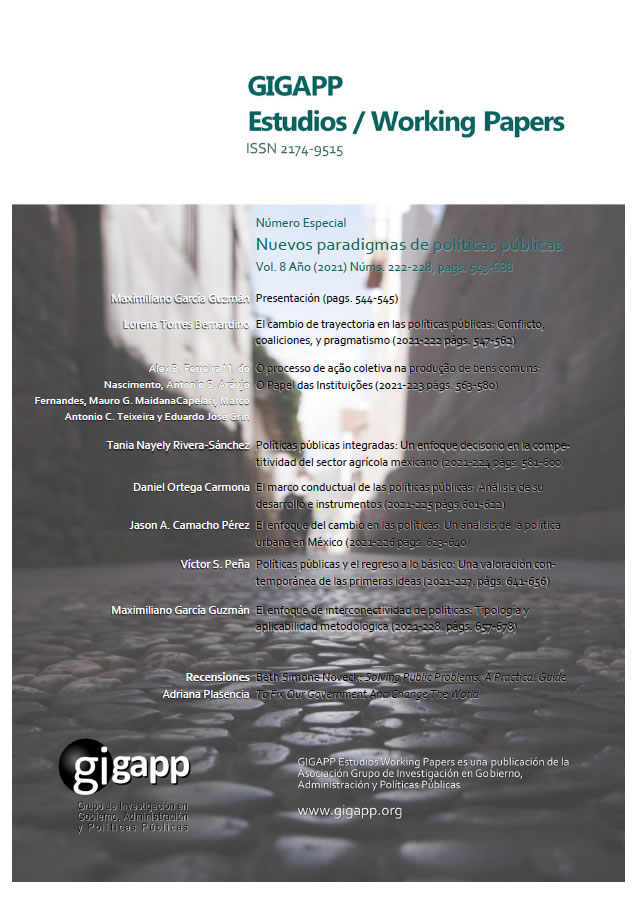El marco conductual de las políticas públicas
Análisis de su desarrollo e instrumentos
Resumen
El marco conductual de las políticas públicas parte un argumento crítico respecto a las máximas de racionalidad que describen al ser humano como un ente económico, utilitario y maximizador, ya que, si este fuera el caso, gran parte de las intervenciones gubernamentales tendientes a procurar el bienestar social, se implementarían con efectividad y sin mayores contratiempos, no obstante, la realidad pone en entredicho tal argumento, toda vez que existen una serie de sesgos cognitivos y heurísticas a nivel individual y grupal que condicionan los resultados deseados por la autoridad pública. En ese sentido, el marco conductual además de profundizar respecto a las variables que condicionan el comportamiento de los agentes, suma al debate la necesidad de analizar una serie de herramientas que pueden ser incluidas por las políticas públicas al momento de diseñar e implementar intervenciones que traten con los problemas públicos y que busquen influir en los comportamientos individuales y colectivos.
Descargas
Citas
Aguilar, L. (1996). El estudio de las politicas públicas. México: Miguel Ángel Porrúa.
Arellano, D., & Barriento, F. (2016). Gobierno conductual: Nudges, cambios de comportamiento (incon-ciente y opacidad). Foro Internacional, LVI(4), 903-940.
Batie, S. (2008). Wicked Problems and Applied Economics. AmericanJournal of Agricultural Economics, 90(5).
Bonome, M. (2009). La racionalidad en la toma de decisiones. Análisis de la Teroría de la Decisión de Her-bert A. Simon. España: NETBIBLIO.
deLeon, P. (1988). Advice and Consent: The Development of the Policy Sciences. Russell Sage Founda-tion.
Deaton, A., & Cartwright, N. (2018). Understanding and misunderstanding randomized controlled trials. Social Sciencie & Medicine, 2-21.
Dunlop, C. (2017). Policy learning and policy failure: definitions, dimensions and intersections. Policy & Politics, 03-18.
Güemes, C., & Wences, I. (2019). Comportamientos incumplidores: contextos y posibles tratamientos políticos. PAPERS Revista de Sociología, 104(1), 75-99.
González, W. (2007). Las Ciencias del Diseño: Racionalidad limitada, predicción y prescripción. Madrid: NETBIBLIO.
Guerrero, O. (1986). La Teoría de la Administración Pública. México: Harlas.
Hallsworth, M., Egan, M., Rutter, J., & McCrae, J. (2020). Behavioural Government. Using behavioural science to improve how governments make decisions. London: Behavioural Insights Team.
Harguindéguy, J. B. (2015). Análisis de Políticas Públicas (2a ed.). Madrid: Tecnos.
Howlett, M., Ramesh, M., & Capano, G. (2020). Policy-Makers, Policy-Takers and Policy Tools: Dealing with Behavioral issues in Policy Desing. Journal of Comparative Policy Analysis: Research and Practi-ce, 487-497.
Ibarra, E. (2010). Herbert A. Simon y su monomanía. El comportamineto humano como comportamiento artificial. Gestión y Política Pública, XIX(1), 155-170.
Kahneman, D. (2011). Pensar rápido, pensar despacio (10a ed.). Barcelona: Penguin Random House.
Kapp, W. (1954). Economics and the Behavioral Sciences. Kyklos, 205-225.
Lasswell, H. (1992). La orientación hacia las políticas. En El estudio de las políticas públicas. México: Mi-guel Ángel Porrúa.
Linder, S., & Peters, G. (1993). Instrumentos de gobierno: percepciones y contextos. Gestión y política pública, 5-34.
Méndez, J. L. (2020). Políticas públicas. Enfoque estratégico para América Latina. México: Fondo de Cul-tura Económica.
Olejniczak, K., Leeuw, P., & Śliwowski, F. (2020). Comparing Behavioral Assumptions of Policy Tools: Framework for Policy Designers. Journal of Comparative Policy Analysis: Research and Practice, 498-520.
Porta, D. D., & Keating, M. (2008). Approches and Methodologies in the Social Sciences. A Pluralist Pers-pective. Cambridge: Cambridge University Press.
Rawat, S. (2016). Behavioral Studies in Economics and Public Policy Journals: A Bibliometric Analysis. Pisa, Italy: European Consortium for Political Research.
Scheider, A., & Ingram, H. (1990). Behavioral Assumptions of Policy Tools. The Journal of Politics, 510-529.
Scopus. (28 de junio de 2021). Scopus. Obtenido de https://www-scopus-com.pbidi.unam.mx:2443/term/analyzer.uri?sid=c683c3f412c3a55b52ec70957cba14ef&origin=resultslist&src=s&s=TITLE-ABS-KEY%28%28+%5bbehavioral++AND+economics%5d++OR++%5bnudges%5d+%29%29&sort=plf-f&sdt=b&sot=b&sl=60&count=16582&analyzeResult
Schubert, C. (2017). Exploring the (behavioural) political economy of nudging. Journal of Institutional Economics, 499-522.
Shafritz, J., & Hyde, A. (1999). Clásicos de la Administración Pública. México: Fondo de Cultura Económi-ca.
Straßheim, H. (2020). The rise and spread of behaviural public policy: An opportunity for critical research and self- reflection. Rewiew of Public Policy, 115-128.
Thomas, M. (2019). Reapplying behavioural symmetry: public choice and choice architectures. Public Choice, 11-25.
Vedung, E. (1998). Policy Instruments: Typologies and Theories. En R. C. Rist, M.-L. Bemelmans-Videc, & E. e. Vedung, Carrots, Sticks and Sermons: Policy Instruments & Their Evaluation (págs. 21-55). New York: Routledge.
Wallerstein, I. (2007). Abrir las ciencias sociales. México: Siglo XXI Editores.
White, M. (2013). The Manipulation of Choice. Ethics And Libertarian Paternalism. New York: Palgrave Macmillan.
Derechos de autor 2021 Daniel Ortega Carmona (Autor/a)

Esta obra está bajo licencia internacional Creative Commons Reconocimiento-NoComercial-CompartirIgual 4.0.
Aquellos autores/as que tengan publicaciones con esta revista, aceptan los términos siguientes:
a. Los autores/as conservarán sus derechos de autor y garantizarán a la revista el derecho de primera publicación de su obra, el cuál estará simultáneamente sujeto a la Licencia de reconocimiento de Creative Commons Attribution-NonCommercial-ShareAlike 4.0 International (CC BY-NC-SA 4.0) que permite a terceros compartir la obra siempre que se indique su autor y su primera publicación esta revista.
Con esta licencia de acceso abierto, los lectores (usuarios) pueden:
- Compartir — copiar y redistribuir el material en cualquier medio o formato
- Adaptar — remezclar, transformar y construir a partir del material
Bajo los siguientes términos:
-
Atribución — usarios deberán dar crédito de manera adecuada, brindar un enlace a la licencia, e indicar si se han realizado cambios. Puede hacerlo en cualquier forma razonable, pero no de forma tal que sugiera que usted o su uso tienen el apoyo de la licenciante.
-
NoComercial — usuarios no puede hacer uso del material con propósitos comerciales.
-
CompartirIgual — Si remezcla, transforma o crea a partir del material, usuarios deben distribuir su contribución bajo la misma licencia del original.
-
Sin restricciones adicionales: los usuarios no pueden aplicar términos legales o medidas tecnológicas que restrinjan legalmente a otros de hacer cualquier cosa que permita la licencia.
b. Los autores/as podrán adoptar otros acuerdos de licencia no exclusiva de distribución de la versión de la obra publicada (p. ej.: depositarla en un archivo telemático institucional o publicarla en un volumen monográfico) siempre que se indique la publicación inicial en esta revista
c. Se permite y recomienda a los autores/as difundir su obra a través de Internet (p. ej.: en archivos telemáticos institucionales o en su página web) antes y durante el proceso de envío, lo cual puede producir intercambios interesantes y aumentar las citas de la obra publicada. (Véase El efecto del acceso abierto).



